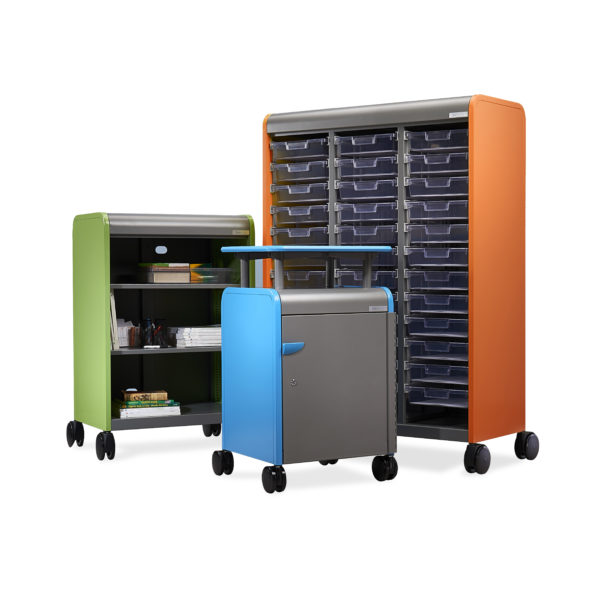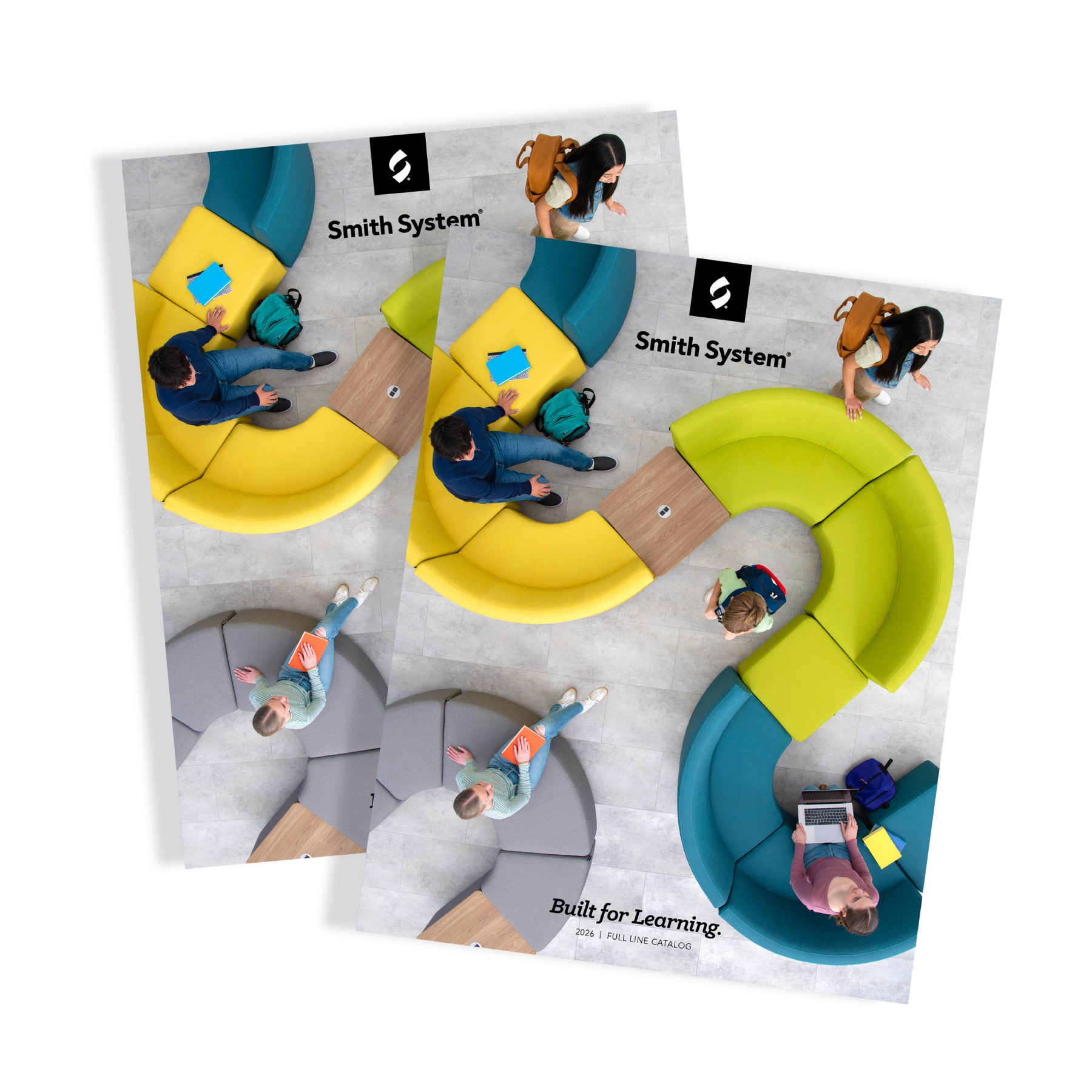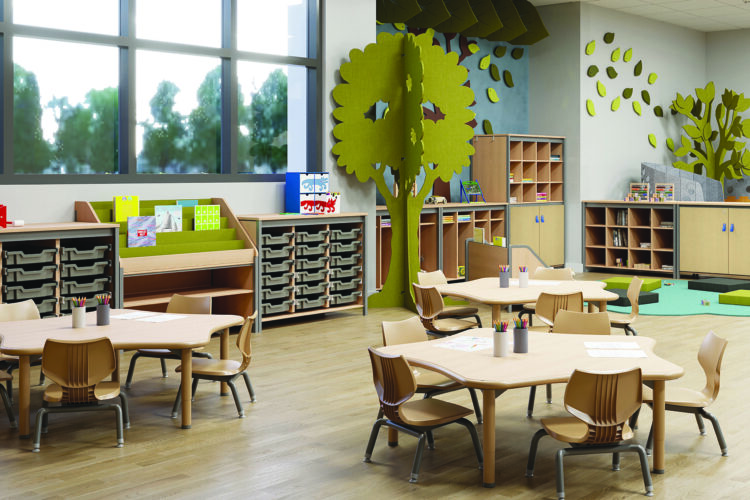
Creating an Engaging Early Learning Environment for Young Learners
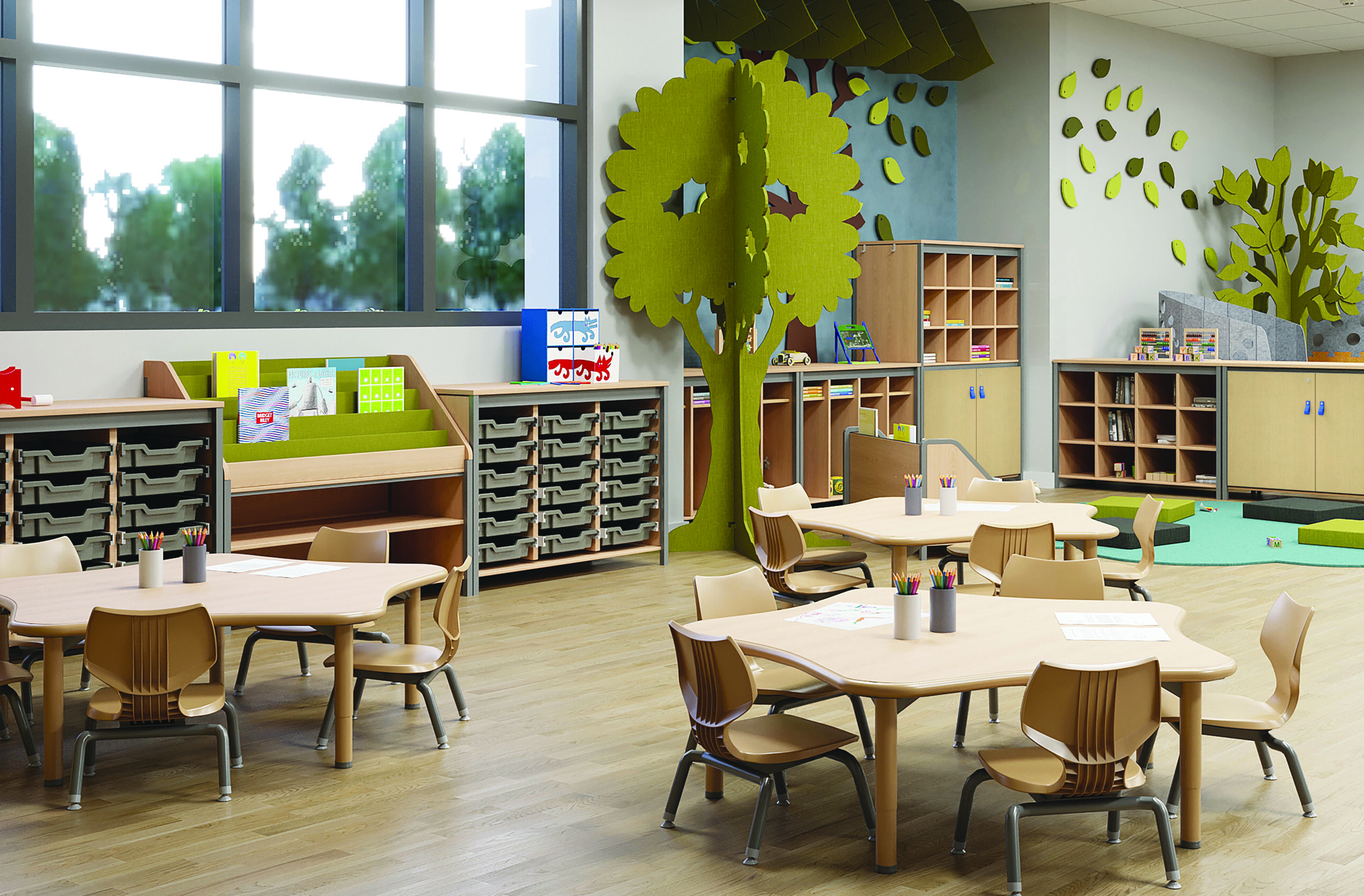
“I love my school!” is a comment that every educator longs to hear, especially those working with the most malleable of minds: preschoolers. That’s frequently happening at the newly opened District 59 Early Learning Center (ELC) in Mount Prospect, Illinois. The dynamic building is a modern example of how a bright, engaging early learning environment can incorporate 21st Century learning principles.
The Tipping Point
Opening the $19 million, 60,000-square-foot building in time for the 2015-16 school year was a challenge. But it was critical to help the district meet its early learning goals, described Tony Rossi, executive director of facilities and operations for the district’s ELC, 11 elementary schools and three junior high schools. Prior to the new build, the district had been operating 16 preschool classrooms spread across five schools. Some had one preschool classroom; some had several. The scattered arrangement made it hard for staff to collaborate and share materials. Also, classroom configurations varied greatly, many with outdated, mismatched furnishings two decades past their prime.
“The district knew the importance of early learning, and it wanted to demonstrate its commitment in two significant ways,” Rossi said. “First, we wanted to provide full-day kindergarten to our communities. Second, we wanted our youngest learners [preschoolers ages three to five] to begin their educational journey in an environment that inspired curiosity and interaction, connected to nature, and welcomed the community.”
District 59’s strategy fit with the rising trend in public schools bringing kids as young as three and four into the learning community. Pre-k advocates believe that doing so can propel student success more than any other intervention done in the following years. As one education blogger wrote, “… pre-k can help close achievement gaps and put students on the path to graduate, go to college and earn significantly more than their peers. All of which equals a high return on investment for such programs.”
Clearly, the district was at a tipping point. It needed to free-up space for full-day kindergarten. But where would the early learners go? An early learning environment program may be a child and family’s first experience with school, so educators wanted to get it right.
Creating an Inclusive Space for Learners
The district chose Legat Architects of Chicago to design and construct a welcoming single-story building on property adjacent to one of the existing junior high schools. The new ELC would provide a centralized preschool location that incorporated the most modern thinking in how to support young learners’ social and emotional development and cognitive learning. Abundant natural daylight, right-sized surroundings, spacious classrooms with learning zones, comfort and color were high on the wish list.
Essential to designing and furnishing the spaces was making them inclusive for all learners. The ELC offers tuition-based programming for typically developing children, grant-based programming for kids found to be at risk for academic and/or social-emotional issues, and special education programming for children who have a disability.
The result: a new ELC featuring 20 classrooms with new furnishings, ample space for staff, three outdoor sensory gardens, a large outdoor secure (courtyard) play area, and indoor multipurpose space. At capacity, the ELC can serve 450 students; about 300 attend this year, served by 67 staff.
According to Principal Michele Ramsey, “The new ELC provides a better, more comprehensive experience for students and their families. The spaces are designed to truly nurture child development in the areas of language, fine motor skills, gross motor skills, social skills and pre-academics.
Choosing Furnishings that Fit
District 59’s ELC team knew that filling their new space miniature elementary school furniture would hinder their curriculum goals. Pre-k students are especially sensitive to their environment. Their behavior is often cued by the space and surroundings. The right furniture can go a long way toward creating an early learning environment that is welcoming, comforting and appropriately stimulating for young learners.
As construction progressed, a small committee of administrators and teachers were charged with evaluating and choosing new furniture, from seating (for kids and adults) to storage. Teachers stressed the ability to re-arrange their spaces to enhance learning.
“Furniture plays an important role in education. We wanted age-appropriate seating and tables that brought color and fun into the space, while also being comfortable and flexible,” Rossi said. To get first-hand insight, he enlisted Melissa Ward, the ELC’s early childhood coordinator. To select a specific manufacturer, the district relied on Dave Tatge, a dealer with Lowery McDonnell Company. Ultimately, the district chose Smith System® for its student and adult seating, and for many of its desks, tables and classroom storage units.
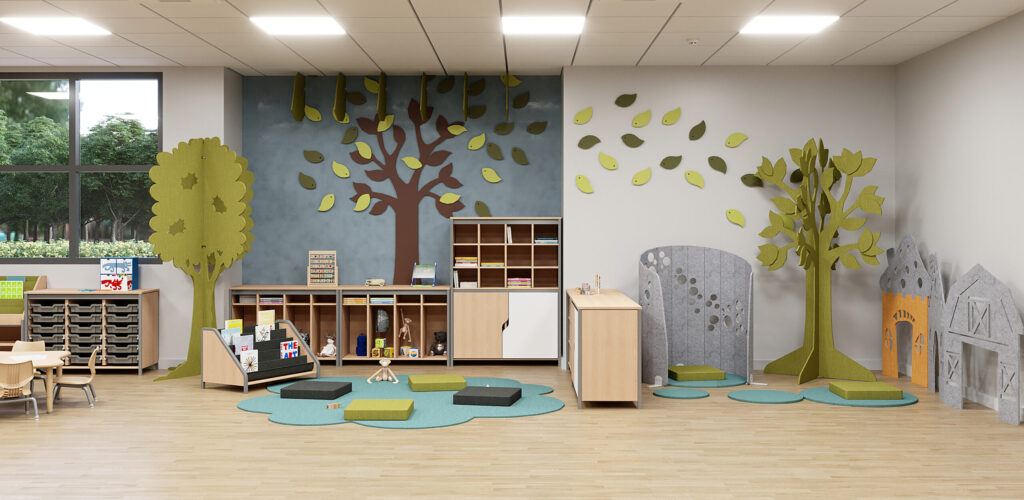
Ward said comfort, ergonomics and flexibility were essential for seating. “In the old preschool classrooms, the student chairs were hard and one-size-fits all. That’s not realistic. Kids learn with their whole bodies and need to move, even while seated.”
The team decided on Smith’s 10-inch and 12-inch Flavors chairs, which were comfortable, provided multi-directional seating positions, and could support kids with lower muscle tone. For teachers and office staff, the district ordered Flavors® adjustable chairs on casters. Ward particularly liked that the chairs were durable, but not heavy, so teachers could easily wheel to kids.
The district paired the chairs with Smith System’s 3-2-1 collaborative desks, which teachers could quickly reconfigure to accommodate one to three students, and Interchange rectangle tables for group learning. Ward stressed the importance of collaborative learning zones in pre-k on up.
“Kids don’t learn in isolation. Learning zones help them find areas of interest, practice sharing, and problem solve together,” she added. “We want to teach students what they can’t look up on Google or YouTube, so they can solve real-world issues when they’re older.”
In addition to the furniture’s many benefits, Rossi knew manufacturer Smith System® could meet the district’s aggressive deadline. “Our biggest challenge was our timeline. We broke ground in November of 2014 and dedicated the building in August of 2015. We needed a manufacturer who could meet our schedule,” Rossi said. “Our construction team and Smith System did an amazing job.”
Storage Solutions
Materials and manipulates can quickly overtake a pre-k classroom. Storage is essential, but it must be the right kind (for example, open shelves can create big distractions.) The early learning environment teachers wanted closed, but easily accessible, mobile storage. The answer was Smith’s Cascade units with doors or organizational totes.
Judy Harris Helm, Ed.D., is president of Best Practices, Inc. It provides consultation and professional development for early childhood and elementary education. Recently, she offered this insight on why storage is an essential component of the preschool environment more than at any other grade level.
“Storage is vital at the preschool level because teachers teach more with materials, such as puzzles and art supplies, than by lecture or reading, and they need a place to hold all those items,” says Harris Helm. “In addition, once students learn concepts or become satiated on materials, they have to change.” Likewise, teachers must shift gears by storing or rotating out items.
Ward specifically liked how Smith’s Cascade® units featured many customizable options, like adjustable shelving, doors and totes. Materials, she said, must be easy accessible for teachers and aids, but not always for kids.
Color Counts
Not to be minimized, color was an important component of the new building. Staff wanted more natural tones, rather than stimulating primary colors. The interior palette was very defined. Ward said Smith System® had the ability to precisely coordinate table trim and chairs to make the spaces appealing, but not overwhelming.
Rave Reviews
Since opening, the ELC has received high praise. Ward said that in addition to kids’ comments, parents walk in and say, “I feel like I’m at home.” For staff members, daily conversations include mentions of how the spaces “are even better than what I had hoped for.”
Ward sees the impact on kids’ learning, too. “It’s all of the little things together that make a big difference on whether kids are ready to learn or not. We’ve creating a very rich environment here where learning can take place now and well into the future.”
For Rossi, the new ELC has been transformational. New construction is stressful for any administrator, fraught with managing exteriors, interiors, landscaping, and new teachers, not to mention budgets. But he concluded, “When you believe in a project, you take more ownership and become passionate about it. Seeing the new Early Learning environment open has been the most rewarding accomplishment of my career.”
Want to learn more about furnishings for early learning environments?
Sources
- “Designing Early Learning Classrooms,” by Ellen Kollie, School Planning & Management, May 1, 2015.
- “Elk Grove Twp. Dist. 59 opens new early learning environment,” by Christopher Placek, Daily Herald, Aug. 25, 2015.
- “What does quality pre-K look like?” by Eva-Marie Ayala, The Dallas Morning News, Education Blog, Oct. 8. 2015.
- https://heckmanequation.org/resource/invest-in-early-childhood-development-reduce-deficits-strengthen-the-economy/
Categories
Recent Posts
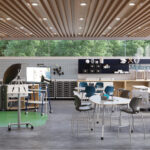 Beyond the Desk: How Intentional Design Transforms Career and Technical Education
Beyond the Desk: How Intentional Design Transforms Career and Technical Education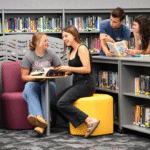 Reimagining the Library: Sierra High School’s Journey to a Flexible Learning Hub
Reimagining the Library: Sierra High School’s Journey to a Flexible Learning Hub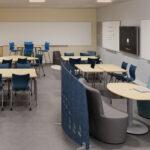 The UDL Blueprint: Furniture That Teaches and Transforms
The UDL Blueprint: Furniture That Teaches and Transforms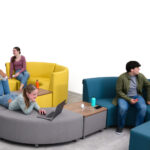 Smith System’s Newest Products for 2026: More Dynamic Furniture Designed to Help Schools Thrive
Smith System’s Newest Products for 2026: More Dynamic Furniture Designed to Help Schools Thrive The Furniture Formula: How Layout Affects Learning Outcomes
The Furniture Formula: How Layout Affects Learning Outcomes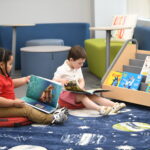 The Power of Play: Building a Strong Foundation in Early Childhood
The Power of Play: Building a Strong Foundation in Early Childhood From Heaters to Hallways: The Manufacturing Journey of Smith System
From Heaters to Hallways: The Manufacturing Journey of Smith System An Invitation to Succeed: How Smith System Helped BAAM Redesign Learning Through Mentorship and Space
An Invitation to Succeed: How Smith System Helped BAAM Redesign Learning Through Mentorship and Space
Recent Posts
- Beyond the Desk: How Intentional Design Transforms Career and Technical Education
- Reimagining the Library: Sierra High School’s Journey to a Flexible Learning Hub
- The UDL Blueprint: Furniture That Teaches and Transforms
- Smith System’s Newest Products for 2026: More Dynamic Furniture Designed to Help Schools Thrive
- The Furniture Formula: How Layout Affects Learning Outcomes

